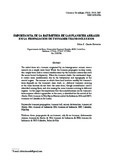Mostrar el registro sencillo del ítem
Importancia de la batimetría de las planicies basales en la propagación de tsunamis transoceánicos
| dc.creator | Chacón Barrantes, Silvia E. | |
| dc.date.accessioned | 2015-06-19T16:12:48Z | |
| dc.date.available | 2015-06-19T16:12:48Z | |
| dc.date.issued | 2009-04-29 00:00:00 | |
| dc.identifier.citation | http://revistas.ucr.ac.cr/index.php/cienciaytecnologia/article/view/2213 | |
| dc.identifier.issn | ||
| dc.identifier.uri | https://hdl.handle.net/10669/14628 | |
| dc.description.abstract | The initial form of a tsunami originated by an homogeneous seismic source consists on a simple wave front. While the tsunami propagates in deep water, this simple form suffers several modifications by the tsunami's interaction with the ocean basin's bathymetry. When the tsunami climbs the continental slope, it suffers more modifications due to the bathymetry and topography of the coastal region. The manner in which these local features modify the tsunami's form depends on the tsunami's form itself, i.e., different tsunamis arriving at the same location do not have the same form, though resemblances can be identified among them, and also among the same tsunami arriving to different regions. In this paper the importance that these modifications on the tsunami's form acquires when it approaches to the coast, is identified for the arrival of the Alaska 1964's tsunami to Hilo Bay in Hawaii and of the Indonesia 2004 and 2005's tsunamis to Colombo in Sri Lanka. | |
| dc.format.extent | - | |
| dc.relation.ispartof | Revista de Ciencia y Tecnología Vol. 25 Núm. 1 y 2 2009 | |
| dc.title | Importancia de la batimetría de las planicies basales en la propagación de tsunamis transoceánicos | |
| dc.type | artículo original | |
| dc.date.updated | 2015-06-19T16:12:48Z | |
| dc.language.rfc3066 | es |


